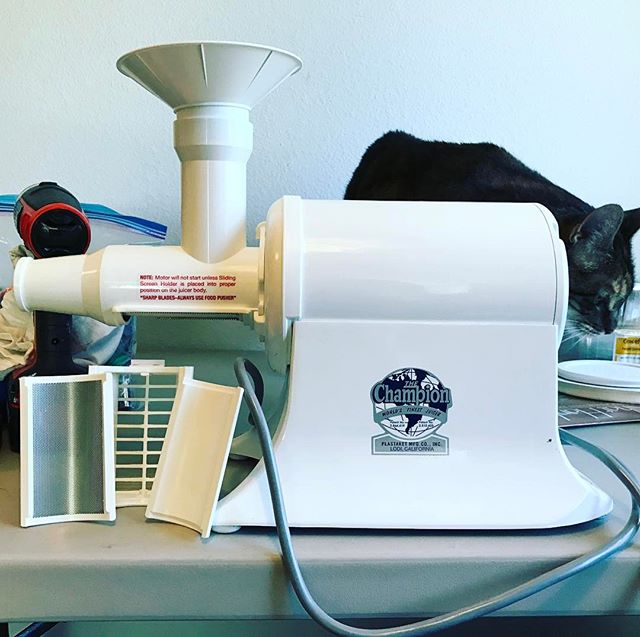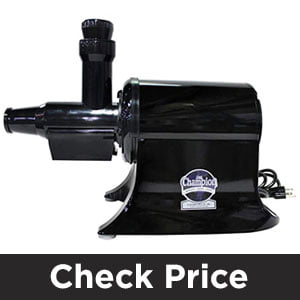With a brand name like Champion, a manufacturer is asking for trouble if they release sub-standard appliances. Thankfully, this is not the case. Champion juicers are professional-standard. In this guide, you’ll find three Champion juicer reviews.
If you’re a casual juicer, you can ignore the Champion brand. There are other models out there that will meet your needs, and the unique design of Champion juicers comes with a steep learning curve.
If you use your juicer regularly, however, this is a brand worth familiarizing yourself with.
3 Best Champion Juicer Reviews
As promised, here are a trinity of Champion juicers that I rate very highly. Any of these appliances are ideal for a busy home. If you have professional juicing aspirations, these models are also highly recommended.
Champion G5- PG710 Juicer
This juicer is designed with commercial interests in mind. You’ll no doubt recognize this model if you frequent juice bars or similar
establishments.
The biggest selling point of this juicer is its durability. It’s backed by a ten-year warranty, which suggests that Champion is confident in its performance, and in many cases, it will last longer than that.
Yes it’s bulky, and it’s certainly not cheap, but in this case, you are paying for quality.
This juicer is made entirely from stainless steel, so there is no risk of plastic ending up in your juice. Assembly and disassembly are quick and easy, as there are fewer components to be constructed.
Most notable is the speed this juicer works at. The eight blades on this appliance spin at 1,725 rotations per minute. That’s an impressive speed for a slow juicer.
It can create foam after prolonged use, however, so you may need to start refrigerating your juice and waiting for it to settle.
This juicer is also not great with leafy greens and wheatgrass. It can be prone to clogging unless regularly lubricated, which in turn leads to overheating. For high performance of job lots of juicing fresh fruits and vegetables, however, it’s a fine – but flawed – appliance.
Good for:
- Professional use.
- Durability.
- High-speed juicing without sacrificing nutrition.
Champion 4000 Juicer
Champion took their commercial-grade juicer and converted it for home use. This led to two models – the 2000 and the more recent upgrade, the 4000.
It’s the 4000 that I’m looking into here. Like the professional model, this appliance is backed by a ten-year warranty. It’s also just as heavy at 23 lbs, though it’s slightly smaller in terms of dimensions. Be aware that this model is made of plastic, though.
Naturally, it’s the performance of this Champion juicer that you’ll primarily be concerned with. The 4000 is a great middle-ground between the commercial juicer and the 2000 model that it has superseded. Having said that, some users prefer 2000.
The usual issues with Champion juicers apply – let’s deal with those first. These juicers struggle with leafy and stringy ingredients.
If your priority is not fresh vegetables, it’s best to look elsewhere. Happily though, Champion has taken steps to rectify this. The 4000 comes with a shield specially designed for leafy greens to improve performance.
If you’re keen on a high-speed juicer that offers great nutritional value, the Champion 4000 is a worthy addition to your kitchen. The The smaller you cut your ingredients, the less likely you are to deal with foam and
froth.
Good for:
- Easy cleaning and assembly.
- High-quality juicing in large quantities.
- Fast use.
Champion G5-NG-853S Juicer
On paper, it’s always advisable to pick up the latest model of any manufacturer. In the case of Champion, that’s the 4000. Some users, however – myself included – prefer 2000.
Let’s address the primary issue with the Champion 2000 before we get started. It will be harder to come by than the 4000, simply because it has been replaced in the eyes of the manufacturer.
This means you may struggle to gain the benefits of the 10-year warranty – you may be forced to buy used, or from a non-approved dealer. Rarity also creates a supply-and-demand issue, potentially leading to a higher cost for a supposedly sub-standard model.
The fact is though, the Champion 2000 has a handful of advantages over its successor. The first is that it is made entirely of metal. With the 4000 being made of plastic, this could be a deal-breaker.
In addition, 2000 uses slightly different grinding techniques. From my experience, this made the 2000 superior juicer for tough ingredients like carrots. It makes short work of root vegetables without any noticeable dip in quality.
The decision is yours. If you are keen on a home model over the commercial Champion juicer, however, I would suggest looking out for 2000 over the 4000 – especially if you can find it cheaper.
Good for:
- Tough ingredients.
- Full metal finish (leading to easy cleaning and less staining.)
- Versatility – parts included in the 4000 can be purchased separately for 2000.
Champion Juicer FAQs
Champion juicers do not come cheap, so you’ll understandably have some questions. Here, I will address the most commonly posed queries about these appliances.
Is a Champion Juicer a Cold Press Juicer?
All three of the Champion juicers that I reviewed above are masticating juicers. This means that, yes, they are cold press juicers.
Make sure that your ingredients will retain high yields and great nutrition. The champion market is the only true masticated juicers on the market due to unique techniques used to grind and crush ingredients.
How Do You Lubricate a Champion Juicer?
Champion juicers use very traditional (some might say old-fashioned, or even outdated) techniques. This means they need to be lubricated after use, or ingredients will clog.
The appliances are packaged with lubricant. When this runs out, rub a little olive oil or coconut oil on the motor shaft using a paper towel. Never use butter or margarine.
Can a Champion Juicer Juice Wheatgrass?
I’ll be blunt – Champion juicers rank poorly in comparison to rivals when juicing wheatgrass. You’ll need a specialist attachment, and to feed the wheatgrass in very small, limited quantities.
If wheatgrass is a core ingredient in your juicing regime, you are better off looking at a different manufacturer.
How Much Does a Champion Juicer Cost?
This depends on which model you pick up, and where you shop. Whichever model you choose, you’re unlikely to get much change from $300 if you buy new.
You could find it cheaper if you buy used, but that means no warranty. There are juicers with a comparable performance at this price point, so do your research before committing.
How Do You Use a Champion Juicer?
Champion juicers have a unique design. This leads to a steep learning curve, which juicing novices may find confusing. Attach the juicer’s cutter to the motor shaft, then apply the body.
For traditional ingredients, drop your fresh fruits and vegetables into the top of the juicer. Use the funnel for smaller items, such as nuts and berries.
Where are Champion Juicers Made?
Champion is an American company, with juicers made in California. This can be a substantial selling point for domestic customers.
Champion is a family-run business with great customer support, so spare parts are easy to acquire. You won’t need to wait for replacement components to be shipped from overseas.
How Do You Clean a Champion Juicer?
Champion juicer parts are not dishwasher-safe, so you’ll need to clean them by hand. Run a bowl of cool, soapy water and use a nylon cloth.
Easy to clean each component, being careful not to scratch the stainless steel. Reapply each piece to the juicer and lubricate the motor. The whole process takes around three minutes.
Wrap Up
This concludes my insights into Champion juicers. These juicers may not be the cheapest on the market, but they produce results for anybody patient enough to tolerate their quirks.
I recommend the G5- PG710 model to any heavy-duty juicer. If you prefer a domestic juicer, try to find 2000.


